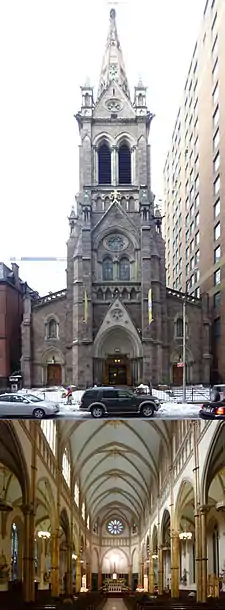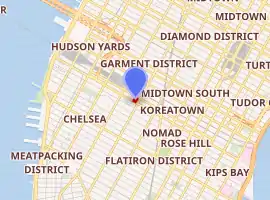St. John the Baptist Church (Manhattan)
The Church of St. John the Baptist is a Roman Catholic parish church in the Roman Catholic Archdiocese of New York, located at 211 West 30th Street between Seventh and Eighth Avenues in the Fur District[3] of the Chelsea neighborhood of Manhattan, New York City. To the church's rear is the Capuchin Monastery of St. John the Baptist, located at 210 West 31st Street across from Pennsylvania Station and Madison Square Garden.
| Church of St. John the Baptist | |
|---|---|
 30th Street facade of church and interior (2011) | |

| |
| General information | |
| Architectural style | Gothic Revival of the French Gothic style (for 1871-1872 church) Brutalist (for monastery) |
| Town or city | Manhattan, New York City |
| Country | U.S. |
| Construction started | 1840 (for first church);[1] 1847 (for second church);[1] 1871 (for present church);[2] 1888 (for tower)[1] |
| Completed | 1840 (for first church);[1] 1872 (for present church);[2][3] 1872 (for former monastery);[1] 1891 (for tower)[1] 1893 (for "casino")[1] |
| Demolished | 1847 (for first church fire)[1] |
| Cost | $175,000 (for 1871-1872 church)[2] |
| Client | Roman Catholic Archdiocese of New York |
| Technical details | |
| Structural system | Sandstone masonry |
| Design and construction | |
| Architect | Napoleon Le Brun (for 1871-1872 church)[2][3] |
| Website | |
| St. John the Baptist Church, Manhattan | |
In 2015, the parish of St. John the Baptist Church merged with the parish of Holy Cross Church on West 42nd Street.[4]
History
The parish was established in 1840 as the second parish to serve German Catholics in New York City, after St. Nicholas' Church, on East 2nd Street, which was established in 1833.[1][5] An historian noted: "Both German parishes had lay trustees that were so overbearing that they drove out several pastors."[2]
The first church erected was a small timber structure.[2] It was dedicated 20 September 1840.[1] The first pastor was the Rev. Zachary Kunze, O.F.M., who, following disharmony with the lay Board of Trustees, resigned in 1844.[1] Kunze left with a portion of the congregation and founded the nearby Church of St. Francis of Assisi.[1] The problems were so great with the Board of Trustees that, following the resignation of Kunze, the parish of St. John the Baptist was under interdict until 1845 when the Rev. J. A. Jakob became its second pastor. More disagreements ensued and the church was again closed in June 1846. It variously reopened with different pastors, but burned down on 10 January 1847.[2][1]
Archbishop John Hughes laid the cornerstone for a new brick church on the site on the 14 March 1847. Until 1851, pastorship of the parish was assumed by the Church of the Nativity until the Rev. Joseph Lutz was appointed pastor. Four months later, the parish was again under interdiction. Lutz explained: "On account of the obstinacy of the parishioners this church was closed and the administration of the Sacraments prohibited by order of His Grace, November 24, 1851." The Rev. P. J. Matschejewski arrived as pastor on 7 March 1852 but remained only two weeks. Father Augustine Danter, O.M.Cap., was appointed as pastor in 1852 and remained until 1869, when he was obliged to retire, after which the church remained closed for some months.[1]
In response to the many disputes, Archbishop of New York Cardinal John McCloskey, suppressed St. John the Baptist in 1870 and requested that the newly founded American Province of the Capuchin Friars assume complete control of the resurrected parish.[2] Under the Capuchins, especially its second Capuchin pastor, the Swiss-born Father Bonventura Frey, O.M.Cap., parish animosity dissipated. Under Frey, the German congregation began to erect the present substantial church.[2] Frey left in 1879 to serve as the Minister Provincial of the Capuchins friars in the United States, and moved to their headquarters in Calvary, Wisconsin.[1] He returned from 1888 to 1891 to prepare the parish for its Golden Jubilee.[1] In 1914 the membership of the parish was 1,500.[1]
In the early 20th century one of the parish's priests was the (now) Blessed Solanus Casey.
Buildings
The present French Gothic-style stone church was built between 1871 and 1872 to the designs of the prolific ecclesiastical architect Napoleon LeBrun,[2] architect of several New York Catholic churches as well as the cathedral in Philadelphia.[3] The cornerstone was laid by Fr. Frey on Pentecost Sunday, June 4[2] or June 11[1] of 1871. The church is 165 feet long and 67 feet wide, originally accommodating 1,200 people, and costing $175,000 to construct[2]


Fr. Frey returned to the parish in 1888 and built the central bell tower in preparation for the church's Golden Jubilee held on 18–19 January 1891 and marked by Archbishop Michael Corrigan, Bishop Wigger of Newark, Archbishop-elect Katzer of Milwaukee and Abbott H. Pfraengle of Newark.[1] The tower has a carillon of five swinging bells cast by the J.G. Stuckstede & Brothers Foundry in St. Louis, Missouri.[2] The peal still rings each day. The church was dedicated on June 23, 1872, by Archbishop John Cardinal McClosky, the first American cardinal.[2]
In preparation for the church's 125th anniversary, it underwent a complete renovation, which lasted several years. The church was re-dedicated on 24 June 1996, the feast day of its patron saint, by Cardinal John Joseph O'Connor, Archbishop of New York. The church's organ and choir gallery, as well as a number of statues and stained-glass windows, were destroyed in a fire on 10 January 1997.[6] The damage was eventually repaired and the organ was replaced with an electronic one.[2]
According to bronze memorial plaques affixed to the wall of the narthex, for the 160th anniversary of the parish and the Great Jubilee Year of 2000, the bell tower was restored by funds provided by Antonio D'Urso and his wife Giovanna Parpo in 2000. The rededication of the St. Joseph, Ave Maria, St. Clare, St. Fidelis Bells were the gift of Kevin Ward, blessed November 30, 1890 by Archbishop McClosky and rededicated November 7, 1998, by Father Bernard Smith, O.F.M, Cap., the Provincial of the Capuchins.
The AIA Guide to NYC (2010) described the church as "...a Roman Catholic Trinity. The interior of white, radiates light. Worth a special visit."[3] In January 2020 an expansion of Pennsylvania Station, to be called Penn South, was proposed. The proposal would expand the track area south to W 30 St and require demolition of the entire block between Eighth and Seventh Avenues, West 31st to 30th Streets.[7]
The brown brick Capuchin Monastery of St. John the Baptist was built in 1974[8] in the Brutalist style. It was sold to a retail property developer in 2016.[9]
School
Fr. Frey had opened a school in a hotel on Sixth Avenue with 50 children during the winter of 1870–1871.[1] An additional floor was added to the rectory to accommodate the school and the Marist Brothers who were in charge of the boys.[1] The Sisters of St. Dominic were in charge of the girls. A four-storey-over-basement Collegiate Gothic monastery block of four bays wide and two bays deep was built behind the church, opening 19 April 1872.[1] The school for young men was opened 7 April 1893.[1] In 1914, the school had 160 boys 200 girls, in the charge of four Marist Brothers and six Dominican Sisters, respectively.[1]
References
- Notes
- Lafort, Remigius, S.T.D., Censor, The Catholic Church in the United States of America: Undertaken to Celebrate the Golden Jubilee of His Holiness, Pope Pius X. Volume 3: The Province of Baltimore and the Province of New York, Section 1: Comprising the Archdiocese of New York and the Diocese of Brooklyn, Buffalo and Ogdensburg Together with some Supplementary Articles on Religious Communities of Women.. (New York City: The Catholic Editing Company, 1914), p.338.
- "St. John the Baptist's Church" on the New York City Chapter of the American Guild of Organists website (Accessed 4 February 2011)
- White, Norval, Willensky, Elliot with Leadon, Fran. AIA Guide to New York City. Fifth Ed. American Institute of Architects New York Chapter Series. (Oxford: Oxford University Press, 2010), p.278. ISBN 978-0-19-538386-7.
- "About Us". Parish of Holy Cross–St. John the Baptist. christinthecity.nyc. Retrieved 17 May 2019.
- Dunlap, David W., From Abyssinian to Zion: A Guide to Manhattan's Houses of Worship. (New York: Columbia University Press, 2004.) p. 215-216.
- Gonzalez, David (22 January 1997). "Church Fire leaves Faith Unscathed". New York Times. Retrieved 2 January 2012.
- "Expand, overhaul, and unify the Penn Station Complex". The Fourth Regional Plan. Regional Planning Association.org. Retrieved 26 June 2020.
- New York City Geographic Information System map
- Schultz, Dana (9 November 2016). "Historic church near Penn Station to be converted to modern retail space". 6sqft.com. Retrieved 25 June 2020.
External links
| Wikimedia Commons has media related to St. John the Baptist Church (Manhattan). |
- Parish of Holy Cross-St. John the Baptist
- "St. John the Baptist" on the New York City Chapter of the American Guild of Organists website
